What Was the Romantic Movement in Art Primarily a Reaction Agains
30 Romanticism
Romanticism, fueled past the French Revolution, was a reaction to the scientific rationalism and classicism of the Age of Enlightenment.
- The ethics of the French Revolution created the context from which both Romanticism and the Counter- Enlightenment emerged.
- Romanticism was a defection against the aristocratic social and political norms of the Historic period of Enlightenment and besides a reaction confronting the scientific rationalization of nature.
- Romanticism legitimized the private imagination as a critical authority, which permitted freedom from classical notions of form in fine art.
- The Industrial Revolution as well influenced Romanticism, which was in part about escaping from modern realities.
- Romanticism: 18th century artistic and intellectual motility that stressed emotion, freedom, and individual imagination.
- Counter-Enlightenment: A movement that arose primarily in tardily 18th and early 19th century Germany against the rationalism, universalism, and empiricism commonly associated with the Enlightenment.
- Avant–garde : originally a military term referring to the vanguard, or those soldiers out in front end.
Overview
Romanticism was an creative, literary, and intellectual motion that originated in Europe toward the end of the 18th century. In most areas the movement was at its peak in the approximate catamenia from 1800 CE to 1840 CE. Romanticism reached beyond the rational and Classicist ideal models to elevate a revived medievalism.
The Influence of the French Revolution
Though influenced by other creative and intellectual movements, the ideologies and events of the French Revolution created the primary context from which both Romanticism and the Counter-Enlightenment emerged. Upholding the ideals of the Revolution, Romanticism was a defection against the aristocratic social and political norms of the Historic period of Enlightenment and also a reaction against the scientific rationalization of nature. Romanticism elevated the achievements of what information technology perceived as heroic individualists and artists, whose pioneering examples would elevate lodge. It also legitimized the individual imagination as a critical authority, which permitted liberty from classical notions of form in art.
Romanticism in Europe had ii major strains: Orientalism and the Gothic. Before in the 18th century novels like The Castle of Otranto by Horace Walpole published in 1764, or The Monk by Matthew Gregory Lewis, published in 1796, created an audition for entertainments that appealed to the imagination and the senses. Dark visions and portrayals of nightmares were gaining popularity in Germany as evidenced by Goethe'southward possession and adoration of paintings past Fuseli, which were said to be capable of "giving the viewer a adept fearfulness." Notable artists included Joseph Vernet, Caspar Wolf, Philip James de Loutherbourg, and Henry Fuseli who frequently turned to the supernatural subjects in Shakespeare's plays equally material.

The Industrial Revolution also had an influence on Romanticism, which was in part an escape from modern realities of population growth, urban sprawl, and industrialism. Indeed, in the second half of the 19th century, "Realism" was offered as a polarized opposite to Romanticism.
Painting in the Romantic Period
Romanticism was a prevalent artistic motility in Europe during the 18th and 19th centuries.
- "History painting," traditionally referred to technically difficult narrative paintings of multiple subjects, but became more than frequently focused on recent historical events.
- Gericault and Delacroix were leaders of French romantic painting, and both produced iconic history paintings.
- Ingres, though firmly committed to Neoclassical values, is seen as expressing the Romantic spirit of the times.
- The Spanish artist Francisco Goya is considered perhaps the greatest painter of the Romantic period, though he did non necessarily self-identify with the move; his oeuvre reflects the integration of many styles.
- The German variety of Romanticism notably valued wit, humor, and beauty.
- The Gothic and the Gothic Revival in compages turned to ideas made pop in literature that often featured horror or terror. Architecture used features from the Gothic of the 12th – 15/16th c. which seemed to participate in that emotionally nighttime moment.
- In England, Edmund Shush will write A Philosophical Research into the Origin of Our Ideas of the Sublime and Beautiful in 1757 which suggested that wild nature could elicit emotions of terror in humans.
- Romanticism: 18th century creative and intellectual movement that stressed emotion, freedom, and individual imagination.
- Neoclassicism: The proper noun given to Western movements in the decorative and visual arts, literature, theater, music, and architecture that draw inspiration from the "classical" art and culture of Aboriginal Greece or Ancient Rome.
- history painting: A genre in painting divers by its subject thing rather than artistic style. These paintings usually depict a moment in a narrative story, rather than a specific and static field of study.
Romanticism
While the arrival of Romanticism in French art was delayed by the agree of Neoclassicism on the academies, it became increasingly popular during the Napoleonic period. Its initial class was the history paintings that acted every bit propaganda for the new government. The key generation of French Romantics built-in betwixt 1795–1805, in the words of Alfred de Vigny, had been "conceived between battles, attended school to the rolling of drums." The French Revolution (1789–1799) followed by the Napoleonic Wars until 1815, meant that war, and the attention political and social turmoil that went along with them, served every bit the groundwork for Romanticism.
History Painting
Since the Renaissance, history painting was considered among the highest and most hard forms of art. History painting is divers by its subject matter rather than artistic way. History paintings usually depict a moment in a narrative story rather than a specific and static subject. In the Romantic period, history painting was extremely pop and increasingly came to refer to the depiction of historical scenes, rather than those from faith or mythology.
French Romanticism
This generation of the French school developed personal Romantic styles while still concentrating on history painting with a political message. Théodore Géricault's The Raft of the Medusa of 1821 remains the greatest achievement of the Romantic history painting, which in its day had a powerful anti-government message. The subject was one of contemporary horror depicting shipwrecked men who had reportedly resorted to cannibalism to survive.

Ingres
Greatly respectful of the past, Ingres assumed the role of a guardian of academic orthodoxy against the dominant Romantic manner represented by his nemesis Eugène Delacroix. He described himself as a "conservator of practiced doctrine, and not an innovator." Nevertheless, modern stance has tended to regard Ingres and the other Neoclassicists of his era as embodying the Romantic spirit of his fourth dimension, while his expressive distortions of course and space make him an of import forerunner of modern fine art.

Delacroix
Eugène Delacroix (1798–1863) had smashing success at the Salon with works like The Barque of Dante (1822), The Massacre at Chios (1824) and Death of Sardanapalus (1827). Delacroix's Liberty Leading the People (1830) remains, with The Medusa, one of the best known works of French Romantic painting. Both of these works reflected current events and appealed to public sentiment.
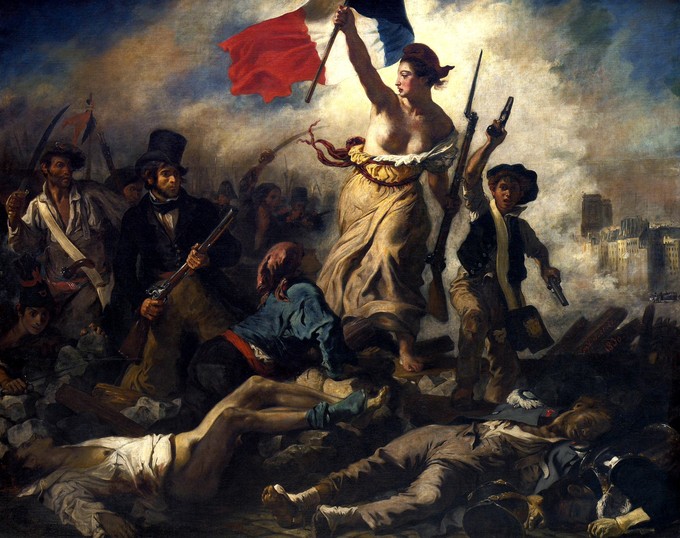
Goya
Spanish painter Francisco Goya is today mostly regarded as the greatest painter of the Romantic menses. Even so, in many ways he remained wedded to the classicism and realism of his grooming. More than any other artist of the period, Goya exemplified the Romantic expression of the artist'southward feelings and his personal imaginative earth. He also shared with many of the Romantic painters a more free treatment of paint, emphasized in the new prominence of the brushstroke and impasto, which tended to be repressed in neoclassicism nether a cocky-effacing finish. Goya's work is renowned for its expressive line, colour, and brushwork as well as its distinct subversive commentary. His 3rd of May, 1808, pictured an incident from the French Peninsular War in which civilians were slaughtered at the hands of Napoleon's mercenaries. The terror it invokes is role of the Gothic mindset of the Romantic flow, but with real-world subject thing.

The Hudson River School
In the United states, a similar motion, called the Hudson River School, emerged in the 19th century and quickly became one of the near distinctive worldwide purveyors of landscape pieces. American painters in this movement created works of mammoth scale in an endeavor to capture the epic size and scope of the landscapes that inspired them. The work of Thomas Cole, the school'southward generally acknowledged founder, seemed to emanate from a similar philosophical position equally that of European mural artists. Both championed, from a position of secular faith, the spiritual benefits that could be gained from contemplating nature. Some of the later Hudson River School artists, such as Albert Bierstadt, created less comforting works that placed a greater emphasis (with a great deal of Romantic exaggeration) on the raw, terrifying ability of nature.
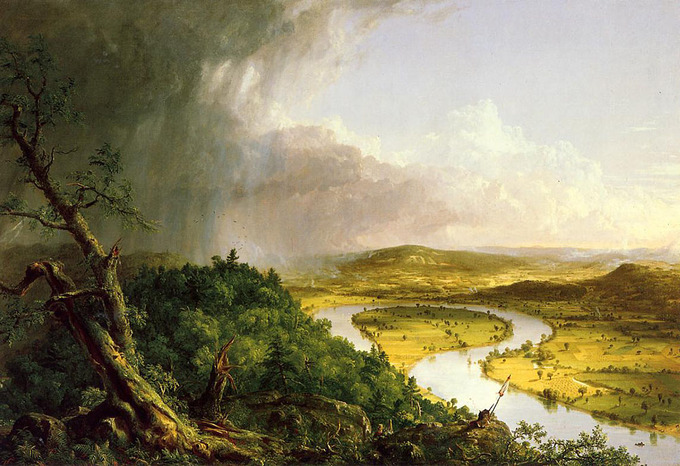
The Gothic Revival
The Gothic strain of Romanticism was also seen in architecture. The Gothic Revival, as it was called, was an architectural motility outset in England during the 1740s that sought to revive medieval forms.
- Gothic Revival sought to revive medieval forms, much like the Neoclassical style sought to revive works from classical antiquity.
- The Gothic Revival occurred as industrialization progressed, in part because at that place was a reaction confronting the use of mechanism and manufactory production.
- While the Neoclassical style of the 18th century was associated with "radical" and liberal perspectives, the Gothic Revival was associated with "traditional" sensibilities, such as conservatism and the monarchy. The Gothic Revival style is characterized by its stone and brick structures, many of which are religious in nature, besides every bit having heavy ornamentation, pointed arches, steep gables, and large windows.
- Gothic revival cottages and smaller buildings, called "Carpenter Gothic," too became popular.
- A. W. N. Pugin was a prominent builder, designer, artist, and critic who was involved in the Gothic Revival manner.
- medievalism: A custom or belief from the Eye Ages.
- gable: The triangular area of external wall adjacent to 2 meeting sloped roofs.
- tracery: Bars or ribs, usually of stone or woods, or other cloth, that subdivide an opening or stand in relief confronting a door or wall equally an ornamental feature.
The Gothic Revival was primarily an architectural motion that began in 1740s England. The style sought to revive medieval forms, much as the Neoclassical mode sought to revive works from classical antiquity. During the 18th century, the ruins of medieval Gothic architecture began to receive newfound appreciation after having been relatively dismissed in the overall history of compages. Some critics believe there was a kind of nostalgia for an enchanted, less rational world that was linked to the perceived superstitions of medieval Catholicism.
In England, the center of the Gothic revival, the move was intertwined with philosophical trends associated with a reawakening of Christian traditions in response to the growth of religious nonconformism. Ultimately, the Gothic style became widespread in the third quarter of the 19th century. While the Neoclassical style of the 18th century was associated with "radical" and liberal perspectives, the Gothic Revival was associated with "traditional" sensibilities, such as conservatism and the monarchy. Every bit industrialization progressed, at that place was an increasing reaction confronting the utilise of mechanism and manufactory production. Supporters of medievalism criticized industrial society, believing the pre-industrial model to be a golden age.
The Gothic Revival style is characterized by its rock and brick structures, many of which are religious in nature, as well as heavy decoration. The most fundamental chemical element of the Gothic mode of architecture is the pointed arch. Columns that support arches are smaller in Gothic buildings, and go along all the manner to the roof, where they go function of the vault. In the vault, the pointed arch can be seen in three dimensions where the ribbed vaulting meets in the center of the ceiling of each bay. This ribbed vaulting is another distinguishing characteristic of Gothic architecture. The slender columns and lighter systems of thrust immune for larger windows and more light in Gothic structures. The windows, tracery, carvings, and ribs brand upwards a bewildering display of decoration where almost every surface is decorated with a profusion of shapes and patterns. Gothic revival cottages and smaller buildings also became popular and are referred to as "Carpenter Gothic." These structures are defined by their use of Gothic elements such every bit pointed arches and steep gables.
A. Due west. N. Pugin was a prominent architect, designer, artist, and critic who was deeply involved in the Gothic Revival. The meridian of his piece of work is seen in the interior pattern of the Palace of Westminster. Pugin designed many churches in England during his career and published a series of volumes of architectural drawings entitled Examples of Gothic Architecture and Specimens of Gothic Compages that remained in print and were the standards for the Gothic Revival for the next century.
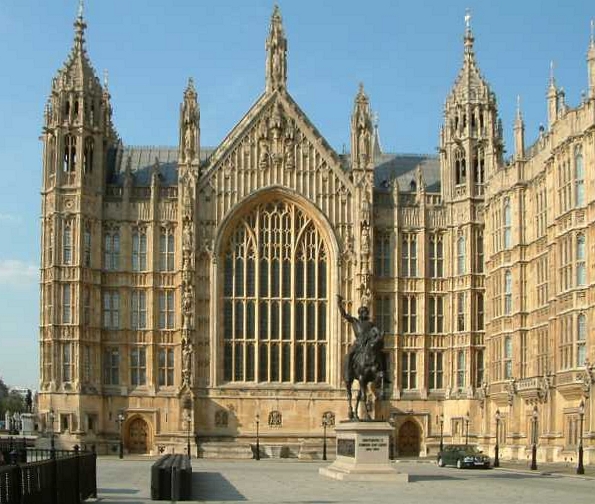
Orientalism
Especially in French republic which had political and economic interests in overseas colonies, protectorates and mandate territories that came nether French rule from the 16th century onward, the picturing of the "Oriental Other" became popular. French republic began with the conquest of Algiers in 1830 and would concord it until the 1960s..1 The paintings that came out of this period are, equally Linda Nochlin and others take pointed out, not a truthful record of the life of the people of these areas, merely a romantic and essentially racist characterization of them every bit exotic, brutal, highly sexualized and essentially uncivilized compared to the French.

Eugene Delacroix was the leading painter of the French Romantic motion and had fabricated a trip to Due north Africa in 1832 to gain visual textile for paintings. The results were romantic fantasies like The Women of Algiers from 1834. The idea of a harem – women who were sexually available to a single man – the Sultan – was part of the exotic appeal.
As opposed to the smooth, academic "licked surface" of Neoclassicism, Romantic paintings similar those of Delacroix are characterized by more than painterly brushstrokes, softer edges or contours, and areas of impasto pigment (thicker paint).
Romantic Mural in England
- The Industrial Revolution also influenced Romanticism, which was in part about escaping from modern realities.
- Romanticism was a defection against the aloof social and political norms of the Historic period of Enlightenment and also a reaction against the scientific rationalization of nature.
- Romanticism legitimized the private imagination as a critical authority, which permitted freedom from classical notions of form in art.
- The refuse of explicitly religious works, a result of the Protestant Reformation, contributed to the ascent in the popularity of landscapes.
- English language painters, working in the Romantic tradition, became well known for watercolor landscapes in the 18th century.
- Artists in the Barbizon School brought landscape painting to prominence in French republic, and were inspired by English mural artist John Constable. The Barbizon school was an important precursor to Impressionism.
- The glorified depiction of a nation's natural wonders, and the evolution of a distinct national fashion, were both ways in which nationalism influenced mural painting in Europe and America.
- The Hudson River School was the well-nigh influential landscape art movement in 19th century America.
- Romanticism: 18th century artistic and intellectual movement that stressed emotion, liberty, and individual imagination.
- plein air: En plein air is a French expression that means "in the open air," and refers to the human action of painting outdoors. In the mid-19th century, working in natural light became particularly important to the Barbizon School and Impressionism.
- Picturesque: as described by Thomas Girtin, the picturesque was a method of creating satisfying landscape drawings, sketches, or paintings past including such formulaic things as a rough, dark foreground, a long calorie-free vista, and ruins.
In England, landscapes had initially but been painted as the backgrounds for portraits, and typically portrayed the parks or estates of a landowner. This changed every bit a result of Anthony van Dyck, who, along with other Flemish artists living in England, began a national tradition. In the 18th century, watercolor painting, mostly of landscapes, became an English speciality. The nation had both a buoyant market for professional works of this variety, and a large number of amateur painters. By the beginning of the 19th century, the most highly regarded English artists were all, for the most office, dedicated landscapists, including John Lawman, J.M.W. Turner, and Samuel Palmer.
The Hay Wain by John Constable, 1821: Lawman was a popular English Romantic Painter.
In Europe, as John Ruskin noted, and Sir Kenneth Clark confirmed, mural painting was the "chief creative cosmos of the 19th century," and "the dominant art." As a consequence, in the times that followed, it became common for people to "assume that the appreciation of natural beauty and the painting of landscape was a normal and enduring part of our spiritual action."
William Gilpin was an English clergyman whose walks and sketches in the countryside resulted in a formula for the creation of pleasant views. His ideas resulted in more constrained landscapes with the sorts of restrained subjects young ladies of skillful convenance would feel comfortable, the civilisation idea, recreating. Jane Austin's heroine in Pride and Prejudice remarks upon being asked, tardily, to join Darcy, Mrs. Hurst, and Miss Bingley on a walk she replies:
"No, no; stay where you are. You are charmingly group'd, and appear to uncommon, advantage. The picturesque would be spoilt by admitting a fourth. Good good day."
She then ran gaily off …
Every bit several critics accept noted, the "subtext" here is Gilpin'south appendix on his prints, where he explains in technical jargon that there are problems in "forming two into a group," while "four introduce a new difficulty in group." But with three y'all "are well-nigh sure of a good grouping." Elizabeth shows herself to be a good student of Gilpin, like her creator; simply the cause for her gay laugh is the piffling joke she shares with those of us who have read Gilpin, since what Gilpin is actually talking about is "the doctrine of grouping larger cattle."2
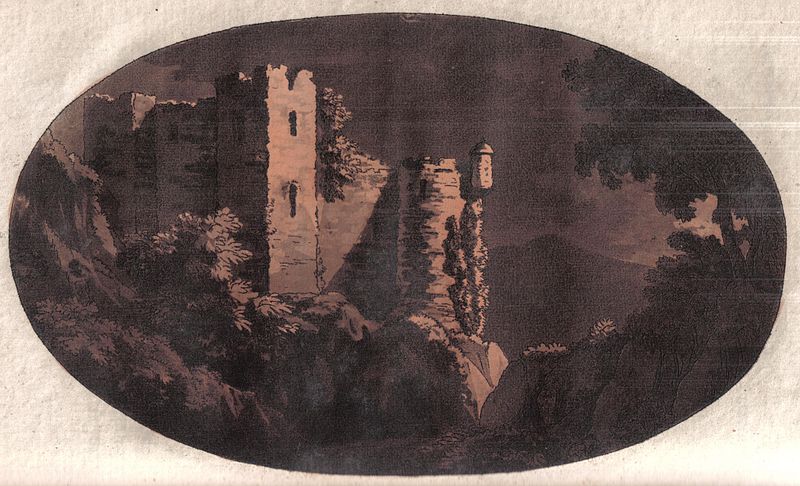

John Lawman's landscapes never moved far from his childhood dwelling house on the River Stour in Suffolk. His father was a successful landowner and farmer, and Constable recorded the life of the rural gentry in the traditional English language countryside that was rapidly giving way to the factories and choking coal smoke of the Industrial Revolution. He studied the erstwhile masters including Claude Lorrain and the Dutch landscapists of the Baroque, but his subject matter was always what he saw as the truth of what he knew best. He refused to travel on the continent, but ironically his work became well-known and admired in France and was influential to the Barbizon School which would, in plough, inspire the Impressionists. Constable, like Turner, was a Romantic at centre in that his piece of work sometimes suggested the themes of Burke'due south Sublime. Turner was more dramatic in his subjects, merely Constable's accent on the nostalgia of the English countryside as it disappeared was also in the Romantic tradition.
J.M.Westward. Turner looked to subjects of a more than Sublime character including those of his own imagination. Unlike Constable, Turner traveled widely in Europe and incorporated elements of landscape, atmospheric condition, sea travel and other subjects into the piece of work. Some of his almost awe-inspiring, or horror-inducing and therefore Sublime, subjects were the shipwrecks and especially the politically inspired The Slave Transport, of 1840. You can run into a good analysis of that work at https://www.khanacademy.org/humanities/ap-art-history/later-europe-and-americas/enlightenment-revolution/five/turner-slave-transport-slavers-throwing-overboard-the-dead-and-dying-draft-coming-on-1840.
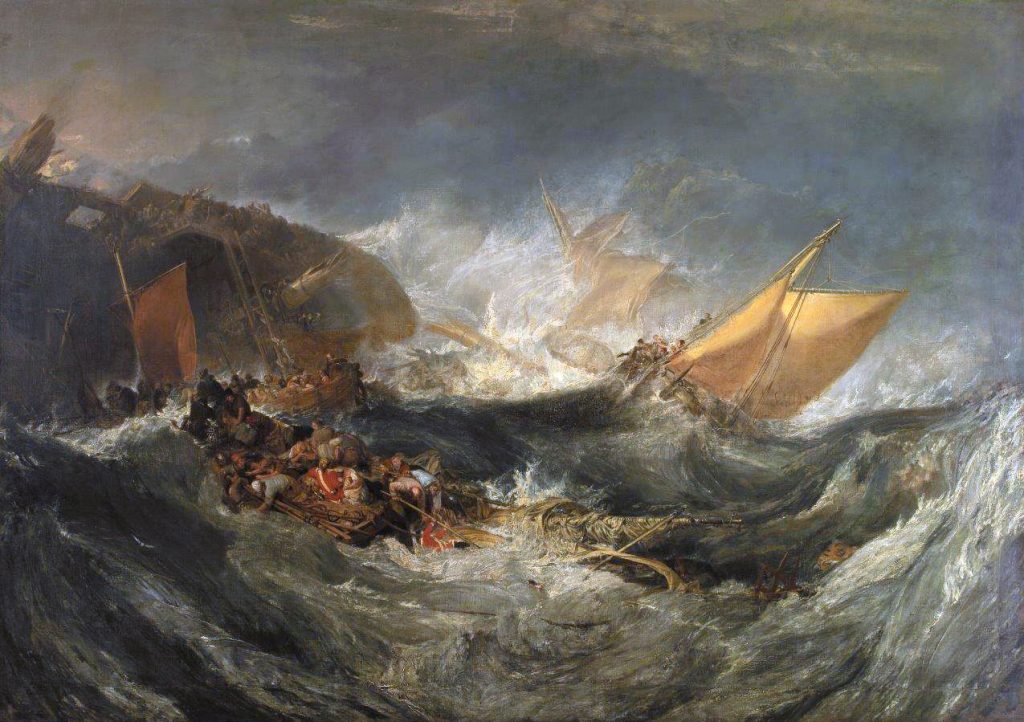
1 https://en.wikipedia.org/wiki/French_colonial_empire
2 A. Walton Litz, "The Picturesque in Pride and Prejudice, Jane Austen Lodge of Northward America, No. 1, Princeton Academy, Princeton, 1979.
Source: https://boisestate.pressbooks.pub/arthistory/chapter/romanticism/
0 Response to "What Was the Romantic Movement in Art Primarily a Reaction Agains"
Post a Comment